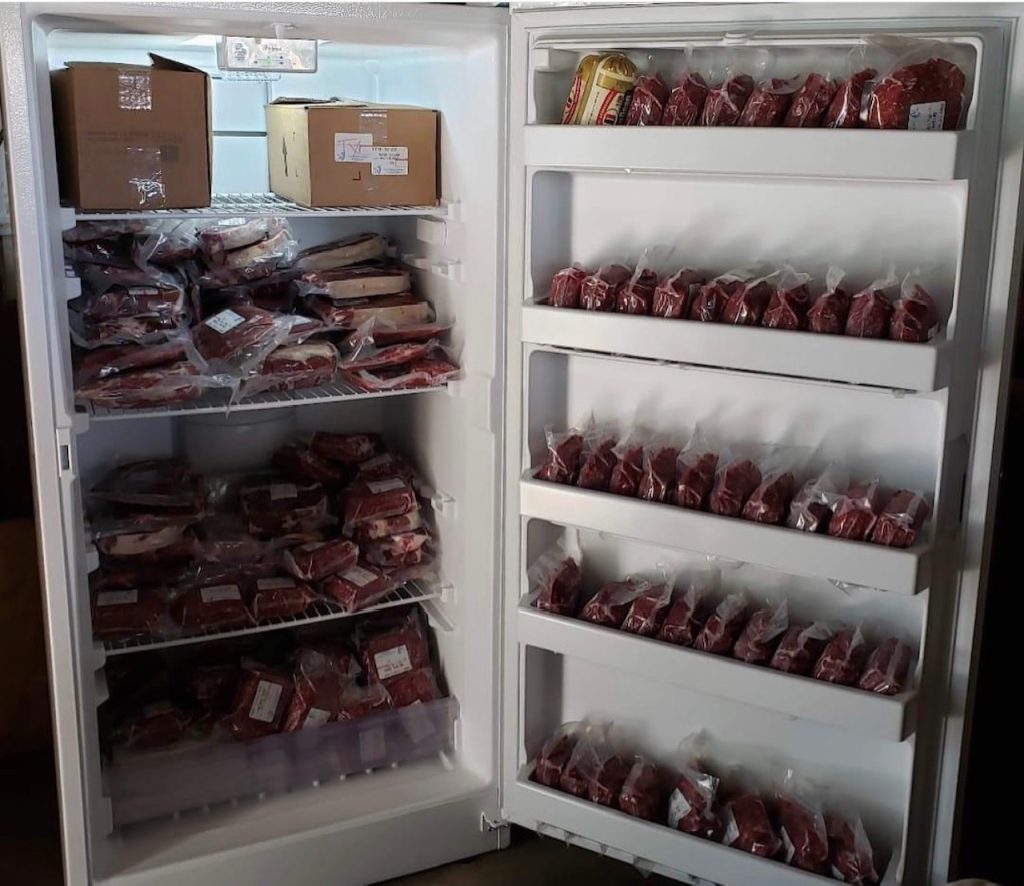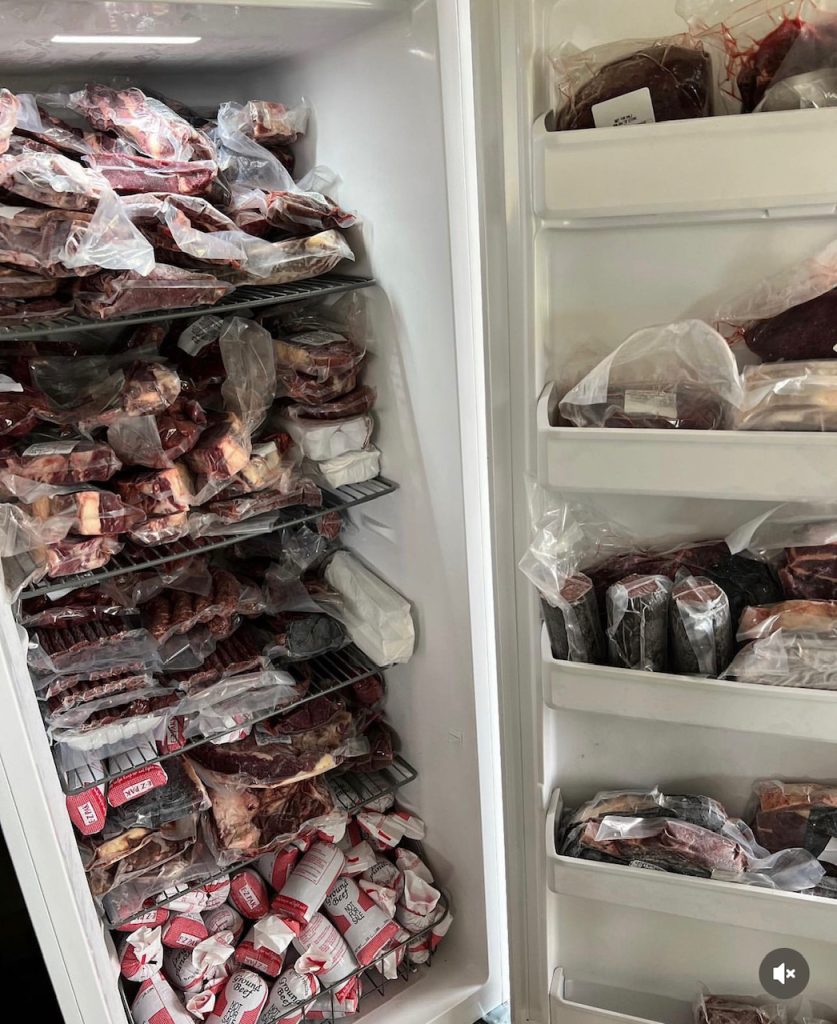Food storage can be a daunting task, especially when it comes to meat. Poorly stored meat not only risks your health but can also lead to unnecessary waste. To shed light on the best practices for meat storage, we have put together a guide to safely storing beef and keeping it at its best. We also discuss best practices for when storing large amounts of beef.

Fridge Storage:
- Wrap It Tightly: When storing meat in the refrigerator, ensure it’s tightly wrapped to minimize exposure to air. Butcher paper is an excellent option as it’s designed for short-term meat storage.
- Freezing in Vacuum Sealed Packaging: Freeze meat in vacuum-sealed packaging to further minimize air and moisture exposure.
- Store-Bought Packaging: Styrofoam grocery store packaging is suitable for short-term refrigerator storage. However, for freezing, it’s advisable to open and wrap the meat more tightly in plastic wrap or freezer paper before sealing it in a Ziploc bag.
Re-Wrapping Leftover Meat:
Vacuum Seal packaging is a great choice for resealing fresh meat or preparing it for the freezer. However, never refreeze meat, as it can result in a loss of texture and flavor due to moisture loss during repeated thawing and freezing.
Freezing Meat:
- Freeze While Fresh: It is recommended to freeze meat while it’s still fresh, ideally with a few “use by” days remaining. This provides flexibility for when you decide to use it, allowing for thawing and cooking time.
- Label Frozen Meat: If you freeze meat at the last moment to prevent waste, label it to remind yourself to cook it as soon as it thaws.
- Storage Duration: Meat can be stored in the freezer for up to a year, but for the best quality, aim to use it within a few months. The less time it spends frozen, the better its quality and integrity.
With TX Bar Grassfed, you receive your meat already frozen and ready to go.
Thawing Meat:
For the best results, thaw the meat gently. Rapid freezing and gentle thawing help maintain meat quality.
- Refrigerator Thawing: Plan ahead by moving meat from the freezer to the refrigerator a day before you intend to use it. Larger cuts may take several days to thaw.
- Cold Water Thawing: In a pinch, you can rapid-thaw small packages of meat in a bowl of cold water. This process takes about an hour for small packages and up to two hours for larger ones. Avoid thawing anything over 3 to 4 pounds using this method.
- Microwave Thawing: Thomason strongly discourages microwave thawing, as it can alter the meat’s texture and quality.
- Oven from Frozen: Never place a partly frozen piece of meat directly in the oven, as it won’t cook evenly and may ruin the meat’s texture.
Optimal Storage for Bulk Beef Purchases
For those who like to plan ahead and make the most of their beef purchases, especially when buying half or a whole beef at a time, proper storage becomes paramount. Not only does it allow you to enjoy high-quality beef at your convenience, but it also ensures you get the best value for your money.
Freezer Size Matters:
One of the first considerations when bulk buying beef is your freezer’s size and capacity. Here are some tips to make the most of your freezer space:
- Assess Your Freezer: Before purchasing in bulk, take a good look at your freezer’s dimensions and layout. Know its storage capacity and limitations. Upright freezers typically have more usable space for stacking and organizing meat packages, while chest freezers offer larger capacities but may require more strategic organization.
- Invest in Extra Storage: Consider investing in additional freezer storage solutions such as wire shelving, sliding drawers, or stackable bins. These can help you maximize space and keep your beef well-organized.
- Package Meat Efficiently: When packaging your beef, opt for flat, rectangular shapes. These are easier to stack and make the most efficient use of freezer space. Vacuum-sealed bags are ideal for this purpose as they conform to the shape of the meat.
- Label and Date Packages: Properly label and date all meat packages to keep track of when you stored them. This ensures that you can prioritize using the oldest cuts first to maintain freshness.
Storing Half Beef or Whole Beef:
We have put together a small guideline for when it comes to storing a half beef or whole beef.
For a Half Beef (6-10 Cublic Space Ideally):
- 6 cubic feet: This would be a tight fit, suitable for storing just the half beef, but it may not leave much room for additional frozen goods.
- 10 cubic feet: This would provide more space for the half beef and some other frozen items.
For a Whole Beef (16-20 Cubic Feet):
- 16 cubic feet: This would be a tight fit for a whole beef and may not leave much room for other frozen goods.
- 20 cubic feet: This would offer ample space for whole beef, and you could also store whole chickens, pigs, or lamb alongside it.

Plan for Rotation:
Whether you have a large or small fridge and freezer, the key to successfully storing bulk beef is planning for rotation. Ensure that you are using the oldest cuts first to maintain freshness and prevent waste. Keep an inventory of what you have in your freezer and fridge to help you keep track.
Bulk buying beef, such as half or whole beef at a time, can be a smart and cost-effective way to ensure a steady supply of high-quality meat. However, it’s essential to consider the size and layout of your freezer and fridge and implement efficient storage and labeling practices. By doing so, you’ll be able to enjoy delicious, well-preserved beef whenever you’re ready to cook, all while making the most of your investment.
Get in touch with us today if you are interested taking the next step on purchasing a half or whole beef.







